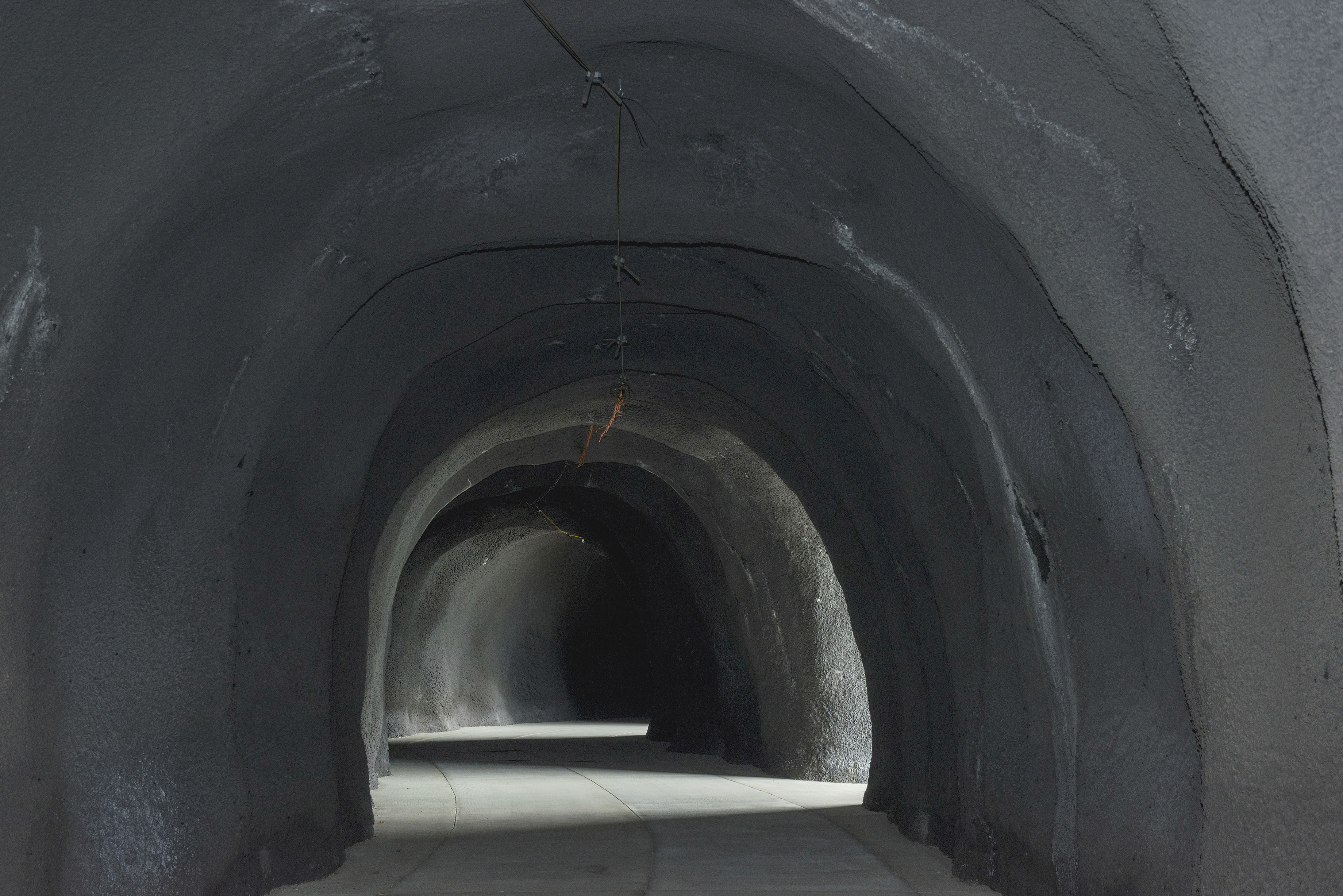
This spring, Oregon transportation officials will open the new Mitchell Point Tunnel along the Historic Columbia River Highway.
Greg Westergaard / Oregon Department of Transportation
There are 77 waterfalls along the Columbia River Gorge, and that’s just on the Oregon side. You can catch a glimpse of some as you drive along Interstate 84.
But for the best views, you need to travel the old Columbia River Highway, which snakes along the basalt walls offering one picture book scene after another.
For example, Terra Lingley with the Oregon Department of Transportation, suggests checking out Hole in the Wall Falls, near Starvation Creek.

Hole in the Wall Falls, shown spilling out of a manmade hole in a rock cliff on Dec. 6, 2023, can be best viewed on a trip along the Historic Columbia River Highway.
Kristian Foden-Vencil / OPB
“It’s a lovely waterfall that comes straight out of a hole in the middle of a cliff,” she said.
ODOT drilled through the basalt walls in 1939 to divert a small creek.
“Nowadays, we would not do this,” she said. “But there was a time when we felt like rerouting a creek to protect our transportation infrastructure was the right thing to do.”
Fixing the Historic Columbia River Highway so more people can see Hole in the Wall Falls and other gems has been one of the state transportation department’s goals for the last 37 years.
ODOT has already created hiking trails along some stretches. Other portions remain open to everyday driving. The hope is that, eventually, people will be able to bike or hike the entire length without a break. And stretches where cars aren’t currently allowed will be open for vintage automobiles on special days.
But that’s in the future. To truly understand the old road, you have to go back to the 1910s. That’s when the newfangled motor car was the hot new thing. Lawyer Sam Hill and engineer Samuel Lancaster wanted somewhere to drive near Portland. They imagined something like the great scenic roads of Europe.

The Historic Columbia River Highway was built in the first half of the 20th century to give new motor car enthusiasts beautiful vistas like those that can be seen from the Mitchell Point Tunnel shown in this undated photo.
Oregon Department of Transportation
So they planned and built the nation’s first planned scenic roadway, 73 miles from Troutdale to The Dalles, linking one beautiful waterfall to the next fabulous vista.
It was nicknamed the “king of roads,” and its creation prompted the construction of posh hotels and restaurants along the way. For example, Vista House on Crown Point offered not only panoramic views but also marble-walled luxury comfort stations for travelers.
But by the 1950s, scenic drives were out of fashion, and people just wanted to get from Portland to the gorge as quickly as possible.
Interstates started linking the country, and I-84 was built right on top of much of the scenic highway. The king of roads turned into something of a pauper’s path. Beautiful old tunnels were filled in or blown up, and a thick carpet of moss grew over the tarmac.
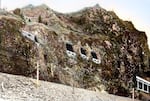
The original Mitchell Point Tunnel was blown up in 1966 to make room for I-84. This spring, a newly built tunnel will open, complete with windows offering unparalleled views.
Oregon Department of Transportation
But then came the environmental movement of the 1970s and an effort to protect the gorge from sprawl.
“The National Scenic Area Act, which was signed by President Reagan in 1986, has a requirement for the Oregon Department of Transportation to restore and reconnect the segments of what they call the old Columbia Highway as a recreation facility,” Lingley said. “The act itself came with, I think it was $2 million at the very beginning to start that work.”
While there was money, there was little support among politicians for rebuilding a crumbling old highway. One problem: there just wasn’t room for it. In places along the gorge, the basalt cliffs butt up so close to the river that there’s barely space for the existing Union Pacific railway and I-84.
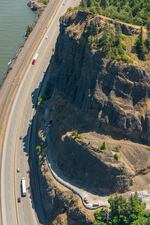
An aerial view of Mitchell Point Tunnel shows how there's very little space between the river, the railway and I-84.
Greg Westergaard / Oregon Department of Transportation
So ODOT worked first on easier stretches of the historic highway, far from the interstate. In 2000, it opened the Mosier Twin Tunnels between Hood River and Mosier.
Brenna Campbell runs the Mosier Market and said the route proved surprisingly popular.
“There are multiple outfitters in Hood River where you can rent an e-bike for the day. So (tourists) will ride over here to Mosier,” she said.

Mosier Market owner Brenna Campbell rearranges goods on the shelves Dec. 6., 2023. Campbell said she's pleased with all the tourists who use the Mosier Twin Tunnels to e-bike between Mosier and Hood River.
Kristian Foden-Vencil / OPB
“They will come get lunch. They’ll hang out for a little bit and then they’ll ride back. They just make a day of it.”
The impact the Twin Tunnels made on tourism galvanized ODOT, and over the last 20 years, it has worked to rebuild the highway.
Where there was moss, crews remade the road. Where there wasn’t space for a road, ODOT built a viaduct climbing up the side of the cliffs.
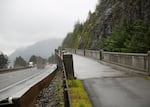
ODOT built a viaduct, shown in this Dec. 6, 2023 photo, along the Historic Columbia River Highway near Starvation Creek because there simply wasn't room to build another roadway.
Kristian Foden-Vencil / OPB
The agency wrapped mesh around crumbling mountains to stop rolling rocks. And this spring, one of the most exciting sections will open: the Mitchell Point Tunnel, a few miles west of Hood River.
The original tunnel was too narrow for modern cars, so it was blown up to make room for I-84.
Lingley said today’s engineers faced the same dilemmas as the original builders.
“We looked at going over (Mitchell Point). We looked about going under it. We looked about going through it,” she said. " And the tunnel was the option that made the most sense.”
So crews blasted out a completely new tunnel in the middle of a national scenic area, complete with five archways offering unique views of the Columbia River.
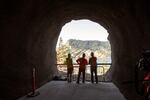
An ODOT crew inspect one of the new windows at Mitchell Point Tunnel.
Greg Westergaard / Oregon Department of Transportation
That will leave just one last stretch west of Hood River. Lingley said it’s going to be the most expensive because there simply isn’t any road there right now.
“Any time you build, make structures, that’s when you see the dollar signs go up,” said Lingley.
ODOT will have to build a new trail into Hood River and a tunnel under I-84 to get it there. It will cost about $50 million, and the agency is now looking for that money.
Lingley said the hope is that finishing the final leg will change the scenic trail from a popular local attraction into something hikers and cyclists from all over the world will want to see.
“So you can stop at towns. Grab a bite to eat. Stay the night. Get on your bike the next morning and continue to the next town,” she said. “Our goal here is a world-class destination. Folks can take three, four, five days to travel along the historic highway. How it was meant to be experienced.”
If everything goes to plan, the trail should be complete in 2027.

Parts of the Historic Columbia River Highway, like this one shown in this Dec. 6, 2023 photo, are already open and offer fantastic views.
Kristian Foden-Vencil / OPB






